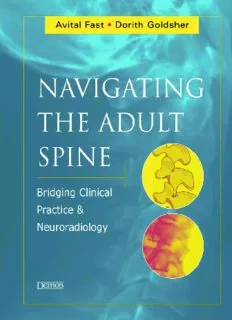
Navigating the Adult Spine. Bridging Clinical Practice and Neuroradiology PDF
Preview Navigating the Adult Spine. Bridging Clinical Practice and Neuroradiology
NNAAVVIIGGAATTIINNGG TTHHEE AADDUULLTT SSPPIINNEE NN AAVV II GG AATT II NN GG TT HH EE AA DD UU LLTT SS PP II NN EE BRIDGING CLINICAL PRACTICE AND NEURORADIOLOGY Avital Fast, MD Professor and Chairman Department of Rehabilitation Medicine Albert Einstein College of Medicine Montefi ore Medical Center Bronx, NY Dorith Goldsher, MD Director, MRI Institute and Neuroradiology Department of Medical Imaging Rambam Health Care Campus and Senior Lecturer in Medical Imaging The Ruth and Bruce Rappaport Faculty of Medicine Technion—Israel Institute of Technology Haifa, Israel Illustrations by Oliver Funk Medicine is an ever-changing science undergoing continual development. Research and clinical experience are continually expanding our knowledge, in particular our knowledge of proper treatment and drug therapy. The authors, editors, and publisher have made every e(cid:625)ort to ensure that all information in this book is in accordance with the state of knowledge at the time of production of the book. Nevertheless, this does not imply or express any guarantee or responsibility on the part of the authors, editors, or publisher with respect to any dosage instructions and forms of application stated in the book. Every reader should care- fully examine the package inserts accompanying each drug and check with a physician or specialist the contraindications stated by the manufacturer. They may di(cid:625)er from the statements made in this book. Such examination is particularly important with drugs that are either rarely used or have been newly released on the market. Every dosage schedule or every form of application used is entirely at the reader’s own risk and responsibility. The editors and publisher welcome any reader to report to the publisher any discrepancies or inaccuracies noticed. 5 DEMOS MEDICAL PUBLISHING, LLC 386 Park Avenue South New York, New York 10016 Visit our website at www.demosmedpub.com © 2007 by Demos Medical Publishing, LLC. All rights reserved. This book is protected by copyright. No part of it may be reproduced, stored in a retrieval system, or transmitted in any form or by any means, electronic, mechanical, photocopying, recording, or otherwise, without the prior written permission of the publisher. LIBRARY OF CONGRESS CATALOGING-IN-PUBLICATION DATA Fast, Avital, 1947– Navigating the adult spine : bridging clinical practice and neuroradiology / Avital Fast, Dorith Goldsher ; illustrations by Oliver Funk. p. ; cm. Includes bibliographical references and index. ISBN-13: 978-1-888799-98-9 (hardcover) ISBN-10: 1-888799-98-6 (hardcover) 1. Spine—Diseases—Treatment. 2. Clinical medicine. 3. Spine— Abnormalities. I. Goldsher, Dorith. II. Title. [DNLM: 1. Spinal Diseases—diagnosis. 2. Spinal Cord Diseases —diagnosis. 3. Spinal Cord Diseases—therapy. 4. Spinal Diseases —therapy. WE 725 F251n 2007] RD768.F37 2007 616.7’3—dc22 2006020444 Designed by Steven Pisano MANUFACTURED IN THE UNITED STATES OF AMERICA 06 07 08 09 10 5 4 3 2 1 This book is dedicated to our families in gratitude for their unwavering support. This page intentionally left blank CCOONNTTEENNTTSS Preface ix Contributors xi 1 Anatomy of the Spine 1 2 Spinal Imaging 9 3 Disc Disorders 29 4 Acquired Spinal Stenosis 41 5 Spondylolysis and Spondylolisthesis 55 6 Spinal Infections 63 7 Spinal Cysts 73 8 Spondyloarthropathy 79 9 Rheumatoid Arthritis 85 10 Metabolic Bone Disease 93 11 Neoplastic Diseases 103 12 Paget’s Disease (Osteitis Deformans) 119 13 Vascular Disorders 125 14 Syringomyelia 135 15 Chronic Adhesive Arachnoiditis 139 16 Coccygodynia 143 17 Imaging of the Postoperative Degenerative Spine 147 Yizhar Floman 18 Spinal Injections and Minimally Invasive Procedures 165 Julian Sosner Index 181 This page intentionally left blank PPRREEFFAACCEE Physicians from wide-ranging disciplines such as physiatry, gerontology, neurology, internal medicine, orthopedics, and neurosurgery frequently encounter patients complaining of spinal pain. Although most patients with neck or back pain do not require a major workup, and their symptoms remit or resolve within a few weeks, some su(cid:625)er from serious ailments that may compromise their quality of life or result in permanent disability or death. For patients with spinal disorders such as malignancy or infection, timely diagnosis is critical and may improve the patient’s chances of recovery. Diagnostic tools such as computed tomography (CT) and mag- netic resonance imaging (MRI) provide important information that enhance the physician’s ability to understand the origin of the patient’s complaints and make the most appropriate therapeutic choices, be they conservative or surgical. Frequently, however, X-rays, CT scans, and MRI examinations are ordered and the reports provided from the radiologist are read without the referring physician personally viewing the actual images. On many occasions, only the radiologist’s conclu- sions are read, while the full radiological report is ignored. Though this approach may be expeditious, it does not assure the best possible care. Ignoring the actual films may deprive the physician of key informa- tion and lead to wrong therapeutic decisions. Furthermore, in many instances the radiologist who interprets the films is provided with scant clinical information or receives none at all. All he or she can do is report what is seen without being able to correlate the neuroradiologi- cal material with the patient’s clinical history and physical examina- tion. As a result, the referring physician is frequently provided with a “menu” of neuroradiological abnormalities a(cid:625)ecting various spinal levels, many of which, or sometimes most of which, bear no clinical relevance. Careful clinical correlation between the patient’s history, physi- cal examination, and imaging studies may help both the radiologist and the referring physician identify the structures and processes respon- sible for the patient’s symptoms.
Description: